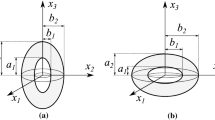Abstract
This work presents the response of a porous heterogeneous energetic material subjected to severe loading conditions. Spherical voids are embedded in an otherwise homogeneous material with the mechanical properties of condensed phase explosives. The effect of imposed shocks on spherical (three-dimensional) voids is compared with the cylindrical (two-dimensional) voids studied in an earlier work, in terms of energy deposition and the maximum temperature reached in the material as the void collapses. It is observed that there is a significant rise in maximum temperature of the energetic material in the presence of spherical voids compared to cylindrical voids. In addition to increasing the maximum temperature, the three-dimensional effects also influence the energy distribution as the void collapses. This study also compares mutual void–void interactions by analyzing different relative positions between two voids for both cylindrical and spherical shapes. Apart from the comparison, this study reinforces the importance of micro-scale dynamics in understanding and quantifying the response of an energetic material to shock loading.










Similar content being viewed by others
References
Camacho, G.T., Ortiz, M.: Adaptive Lagrangian modelling of ballistic penetration of metallic targets. Comput. Methods Appl. Mech. Eng. 142(3–4), 269–301 (1997)
Mali, V.: Flow of metals with a hemispherical indentation under the action of shock waves. Combust. Explos. Shock Waves 9(2), 241–245 (1973)
Wright, T.W., Batra, R.C.: The initiation and growth of adiabatic shear bands. Int. J. Plast. 1(3), 205–212 (1985)
Cooper, S., Benson, D., Nesterenko, V.: A numerical exploration of the role of void geometry on void collapse and hot spot formation in ductile materials. Int. J. Plast. 16(5), 525–540 (2000)
Kapahi, A., Sambasivan, S., Udaykumar, H.S.: A three dimensional sharp interface cartesian grid method for solving high speed multi-material impact, penetration and fragmentation problems. J. Comput. Phys. 241, 308–332 (2013)
Baer, M.: Mesoscale modeling of shocks in heterogeneous reactive materials. Shockwave Sci. Technol. Ref. Lib. 2, 321–356 (2007)
Khasainov, B. et al.: Two-phase visco-plastic model of shock initiation of detonation in high density pressed explosives. In: Proceedings of 7th Symposium (International) on Detonation. Annapolis, MD (1981)
Swantek, A., Austin, J.: Collapse of void arrays under stress wave loading. J. Fluid Mech. 649(1), 399–427 (2010)
Baer, M., Nunziato, J.: A two-phase mixture theory for the deflagration-to-detonation transition (DDT) in reactive granular materials. Int. J. Multiph. Flow 12(6), 861–889 (1986)
Lee, E., Tarver, C.: Phenomenological model of shock initiation in heterogeneous explosives. Phys. Fluids 23, 2362–2372 (1980)
Kapahi, A., Udaykumar, H.: Dynamics of void collapse in shocked energetic materials: physics of void-void interactions. Shock Waves 23(6), 537–558 (2013)
Najjar, F. et al.: Computational study of 3-D hot-spot initiation in shocked insensitive high-explosive. In: Proceedings of AIP Conference; Conference date: 26 June 1–July 2011, Location: Chicago, Illinois, vol. 1426, p. 255 (2012). doi:10.1063/1.3686267
Menikoff, R., Sewell, T.: Constituent properties of HMX needed for mesoscale simulations. Combust. Theory Modell. 6(1), 103–125 (2002)
Kapahi, A., Mousel, J., Sambasivan, S., Udaykumar, H.S.: Three-dimensional compressible multi-material flow computations using a parallelized levelset-based solver. In: Plasticity of Crystalline Materials: From Dislocations to Continuum. Wiley, New York (2011)
Sambasivan, S., Kapahi, A., Udaykumar, H.S.: Simulation of high speed impact, penetration and fragmentation problems on locally refined Cartesian grids. J. Comput. Phys. 235, 334–370 (2013)
Kulikovskiĭ, A.G., Pogorelov, N.V., Semenov, A.Y.: Mathematical Aspects of Numerical Solution of Hyperbolic Systems, vol. 118. CRC Press, New York (2001)
Simo, J., Hughes, T.: General Return Mapping Algorithms for Rate-Independent Plasticity. Elsevier, Tucson (1987)
Poirier, J.P.: Introduction to the Physics of the Earth’s Interior. Cambridge University, Cambridge (2000)
Shu, C.W., Osher, S.: Efficient implementation of essentially non-oscillatory shock capturing schemes II. J. Comput. Phys. 83(1), 32–78 (1989)
Liu, X., Osher, S.: Convex ENO high order multi-dimensional schemes without field by field decomposition or staggered grids. J. Comput. Phys. 142(2), 304–330 (1998)
Sethian, J.A.: Level Set Methods and Fast Marching Methods. Cambridge University Press, Cambridge (1999)
Kapahi, A., Mousel, J., Sambasivan, S., Udaykumar, H.S.: Parallel, sharp interface eulerian approach to high-speed multi-material flows. Comput. Fluids 83, 144–156 (2012)
Kapahi, A., Sambasivan, S., Udaykumar, H.S.: Simulation of collapse and fragmentation phenomena in a sharp interface eulerian setting. Comput. Fluids 87, 26–40 (2012)
Acknowledgments
This work was performed under grants from the AFOSR Computational Mathematics program (Program Manager: Dr. Fariba Fahroo) and from the AFRL-RWPC (Computational Mechanics Branch, Eglin AFB, Program Manager: Dr. Michael E. Nixon). This research was supported in part through computational resources provided by The University of Iowa, Iowa City, Iowa.
Author information
Authors and Affiliations
Corresponding author
Additional information
Communicated by W. Proud.
Rights and permissions
About this article
Cite this article
Kapahi, A., Udaykumar, H.S. Three-dimensional simulations of dynamics of void collapse in energetic materials. Shock Waves 25, 177–187 (2015). https://doi.org/10.1007/s00193-015-0548-5
Received:
Revised:
Accepted:
Published:
Issue Date:
DOI: https://doi.org/10.1007/s00193-015-0548-5




